Product Requirements:
Device:
Windows 2000 or XP, Mac OS X v10.2.6 or 10.3
palmOne has been in the PDA market for a
little over 9 years now. I think most of you will admit that they pretty much
started this ‘revolution’ that we know as handheld computing. Yes, I know there
were other handheld PDAs before the Palm Pilot 1000 and 5000, but none of them
took the world by storm like those first Palms did. In these past 9 years, we’ve
seen many evolutionary changes to palmOne PDAs. We’ve seen monochrome screens
turn into color screens, 128k of memory turn into 128mb of memory and so on.
Palm has been criticized by always coming out with new PDAs that only have
evolutionary changes instead of revolutionary changes. With their latest
offering, some may argue that the LifeDrive Mobile Manager is yet another such
PDA. The main new feature of this model is a 4gb microdrive built into it. It is
actually the first mainstream PDA to have this feature. So, is this an
evolutionary or revolutionary change? You will have to be the judge as I walk
you through this new device.
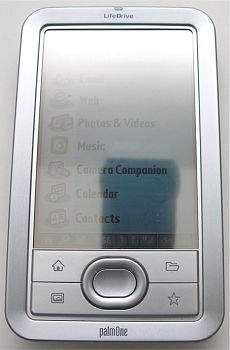
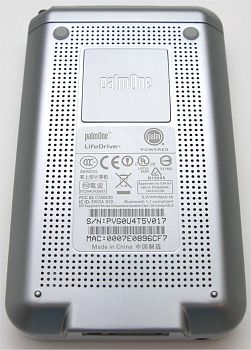
Hardware Specs
Processor: 416MHz Intel XScale Processor
Operating System: Palm OS software (Garnet) v5.4.8
Memory: 32MB on board RAM (for program caching), 4GB microdrive (3.85GB user accessible)
Display: TFT color display with backlight, 320 x 480, 16 bit color / 65,000+
colors
Interface: USB 2.0 (for HotSync® operation), Infrared, Bluetooth v1.1, WiFi
802.11b
Dimensions and Weight: 4.76 x 2.87 x 0.74in (121 x 73 x 19mm), 6.8 oz. (190g)
(including stylus)
Power: 108-132VAC, 60Hz US;100-240VAC, 50-60Hz Int’l
Battery: 1660mHa Lithium-ion polymer rechargeable battery (internal – non user
removable)
Expansion: SD card slot (Secure Digital), supports MMC and SDIO cards
Package Contents
LifeDrive PDA
Stylus
Leather slip case
USB cable with sync button
AC adapter
Graffiti 2 sticker
Screen protector
Read This First document
License Agreement
Accessories Catalog
Software Installation CD
My first impression of the LifeDrive was that it looked like the offspring of an
Apple Powerbook and a tablet PC. The top and bottom shells are made of aluminum,
with grey plastic sandwiched in between. This device is pretty large when
compared to most PDAs currently on the market. In hand it has a definite heft to
it. Although the LifeDrive is thick, the beveled sides allow it to remain
comfortable while holding it. As always, my first test with any handheld device is the
Gadgeteer creak test. So, I squeezed it, shook it, tried to flex it (gently) and
was impressed by its solidness. The casing does not flex or creak when squeezed.
The only noises I could generate were a few rattles from the side buttons when
shaking the device. Since I don’t normally go around shaking my PDAs like a
maraca, I will say that the LifeDrive passed the test with flying colors.
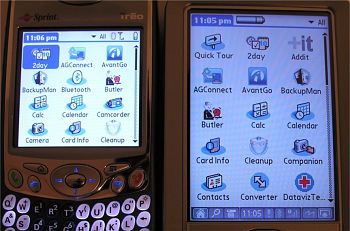
Left to right: Treo 650 on full brightness, LifeDrive on full
brightness
The main focus on the front of the LifeDrive is the display. The way the case
is constructed, it even frames the screen like a picture frame. While the
display is crisp and easy to read, on full brightness, the display is noticeably
dimmer than my Treo 650 when on full bright. Colors aren’t quite as vibrant as
they could be. If I hadn’t been using a Treo 650 for the past few months, I
might not even notice this…. but since I have, I felt that I should put
that out there.
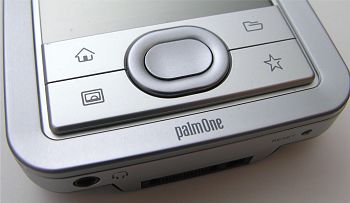
Below the display are the 4 main application and 5-way navigator button. The
application buttons are assigned to Favorites, File manager, Media and pTunes by
default. Of course, you are free to reassign them to any applications you
desire. The application buttons are large flat plastic slabs and have great
tactile feedback. The 5-way navigator button is oval shaped and made of metal (I
think…). The middle (select) button is smooth and concave. Surrounding it is a
ring that can be pressed up, down, left and right.
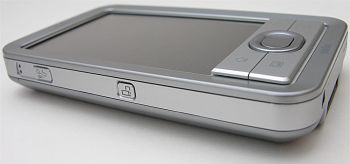
On the left side of the LifeDrive there are two square buttons. One that
toggles the screen from portrait to landscape, and one for the voice memo.
Holding the voice memo button will launch the app and initiate recording.
Recording stops when you let go of the button. Above the button are two small
holes for the microphone.
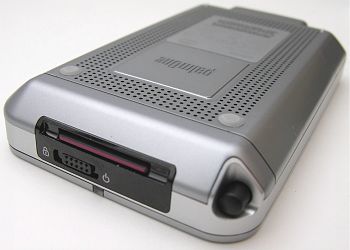
The top of the LifeDrive has the Power / Hold switch, IR port, SD slot,
status LED and stylus silo. When clicked all the way to the left, the Power
switch is in Hold mode. In this mode, button presses will have no effect. To
power the device on and off, you slide the spring loaded switch all the way to
the right and let go. I hate this type of power switch because it seems like I
never slide it far enough the first try to toggle the power status. I’ve taken
to using one of the application buttons for powering on the device instead.
The status LED blinks orange when the internal microdrive is being accessed
and blinks green when an alarm goes off. The LED glows amber while the device is
being charged. I assumed it would turn green when fully charged, but I’ve yet to
see this happen. It just remains amber.
The stylus included with the LifeDrive is identical to the telescoping
variety used with the Tungsten T series. This has been one of my favorite stock
styli used with a PDA, so I’m glad to see it here.
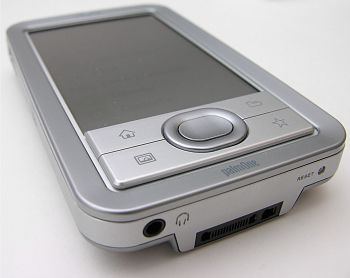
The bottom of the PDA has the 3.5mm earphone jack, hotsync port and reset
switch. This devices uses the same hotsync (multi connector) as current palmOne
devices. The LifeDrive ships with the same hotsync cable (with sync button) that
my Treo 650 shipped with. I’m disappointed that a regular cradle was not
included with this pricey PDA. That seems to be the trend these days and I don’t
like it… Cables are ok for traveling, but I want a cradle for my desk.
The LifeDrive uses a 1660mAh Lithium Ion battery. Problem is that the battery
is not user swappable. There isn’t a door on the back of the PDA for access to
the battery. There aren’t even any screws on the back of this device to
facilitate battery removal of any kind. Since the LifeDrive is being marketed as
a mobile manager that can allow you to view your photos, movies, MP3s, Word,
Excel, etc. You would think that they have might given us the ability to bring
along a spare battery in the event that we run out of juice while doing all this
cool stuff. But nope… we are out of luck. I’ve only had the LifeDrive for a
couple of days, so a full battery test will have to be added to the second half
of the review.
The sound quality through the earphone jack (BTW: palmOne didn’t include
earbuds with this device… at least there weren’t any in the eval box I
received. Not that I ever use the freebies that come with PDAs…) is very good.
Max volume will make your ears bleed. Sound quality through the built in speaker
is fine as long as you don’t turn it all the way up to max. Doing so will give
it a slightly distorted sound depending on the song. That said, this PDA has the
loudest alarm that I’ve ever heard. Set to high, I think it could wake the dead!
I also wanted to mention that the location of the built in speaker can be a
little inconvenient if you like to hold the PDA in your hand while watching
videos. Since the speaker is on the back, it is easy for your hand to muffle the
sound.
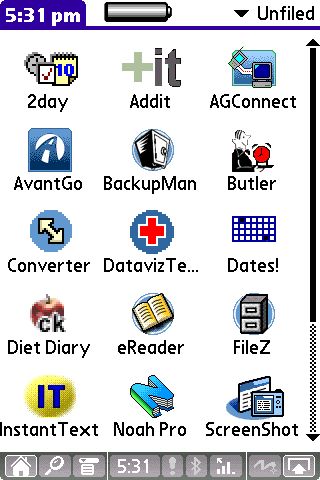
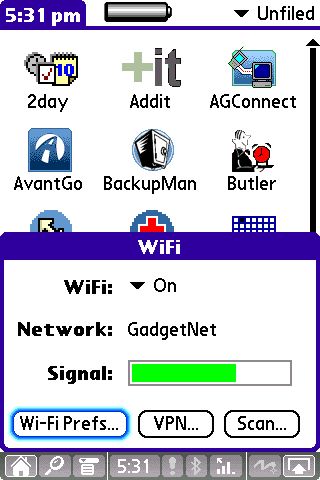
When it is all said and done, the LifeDrive has two major hardware features:
built-in WiFi and a built-in 4gb microdrive. This is palmOne’s first PDA since
the Tungsten|C to offer WiFi. I have to say
that it’s about freaking time! Having WiFi built in is much easier to deal with
than having to carry around an SD WiFi card. Setting up and connecting to an
access point with the LifeDrive was a snap. There’s even an icon on the menu bar
now just for WiFi. Tapping this icon shows the WiFi power status, network name
and signal strength. If you’re not connected to an access point, you can just
click the connect button and the PDA will search for networks. This is a
painless operation and makes surfing via WiFi on the LifeDrive a real joy. This
is especially true if you rotate the display. I couldn’t get my screen shot
program to capture the rotated screens, but you get an idea of how websites look
from the pictures below.
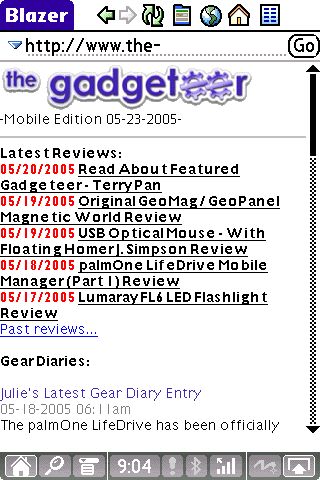
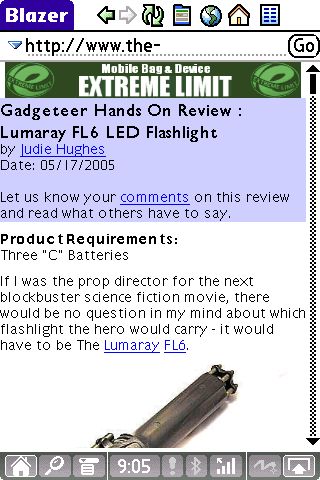
Of course the biggest news with the LifeDrive is the built in 4gb microdrive.
Although microdrives have been around for awhile now, palmOne has not had a PDA
with a CF slot in order to use one. So instead of adding a slot, they just
slapped the hard drive directly into the body of the PDA. They went with an
Hitachi drive due to their faster seek times. That’s important when your OS and
all your applications are stored directly on the drive. The only memory on the
PDA itself is 32mb of RAM where the programs run from. When I learned about
this, I was worried about several things: battery life, noise, vibration and
system speed.
As far as battery life, I mentioned above that I’ve yet to conduct a real
test. But I will say that so far the battery life has not been too shabby at
all. I’ve surfed, played videos, loaded programs, played games, listened to MP3s
and still had more than 50% battery power left.
Some of you might be wondering if you can hear and feel the drive spinning
inside the PDA. So far I’ve not noticed any hard drive type noises at all. I
have noticed the very slightest hint of vibration though. It’s almost
imperceptible, so it isn’t a problem whatsoever.
Now we can talk about a big issue: system speed. Since the hard drive in this
device is used for EVERYTHING, this means that you will notice a definite lag
when launching applications as it has to go out and load the app from the drive.
While you won’t see an hourglass or anything like that, you will notice a blank
white screen for a second or two as an application is loading. This does not
happen all the time, because there is 32mb of on board RAM where programs are
cached. So, if you happen to launch an application that you had opened not long
before, it should pop right up with no lag.
I’ve also noticed that doing a soft reset takes quite awhile longer than
other Palm PDAs I’ve used. Hard resetting now gives you 2 choices: Quick Erase
which takes 5 minutes and Secure Erase that can take 30 minutes. It should go
without saying that a hard reset will wipe the drive of all your files, apps,
etc.
My Treo 650 has a slower processor (315mhz), but feels much snappier than the
LifeDrive with its 416mhz processor. Could I overlook this lag as the price you
have to pay for gaining 4gb of space? Yes, I suppose I could… But I’m not sure
it is entirely worth it for me as I have a 1gb SD card in my Treo that isn’t even full
yet. 2gb cards are already available, so 3 and 4gb cards should follow soon.
That said, the 4gb in the LifeDrive is built-in. I don’t have to remove it if I
want to use the SD slot for something else… That’s where the LifeDrive shines.
It has a card slot, a hard drive and WiFi all in one package.
The LifeDrive package is very nice but could be better. The screen could be
brighter. The system speed could be faster. Hardware is one thing, software is
another… This PDA has some new software tools that are very interesting and
may make this device worth the $500 price tag.
Included in ROM:
Quick Tour – Simple overview of features.
Addit – Application that enables you to download and buy Palm software
Calc – Same old calculator.
Calendar, Contacts, Tasks, Memos, Note Pad – PIM applications.
Card Info – Displays data about the SD memory card in the slot.
Camera Companion – Allows you to use your LifeDrive as a card reader for SD
cameras.
Contacts – Address book
Dialer – Bluetooth phone dialer
Documents to Go v7.0 – Word, Excel and PowerPoint viewer and editor that can
read and write native files. No more conversions are needed.
Drive Mode – Simple toggle application that turns on/off USB mode.
Expense
Favorites – Simple application launcher
Files – Finally, an actual file manager. Not nearly as good as
File Man, but it’s a start.
Hotsync
Media – Picture and Video (ASF, MPEG1, MPEG4) viewer
Memos
Notepad
Prefs
Pocket Tunes – MP3 player
SMS
Solitaire
Tasks
VersaMail 3.1 – Email client
Voice Memo
Blazer 4.1 – Web Browser
World Clock
Included on the CD:
Palm Desktop
File Transfer (Windows only)
Microsoft Outlook Conduits (Windows only)
Phone Link Updater
Quick Install (Windows only)
Documents to Go Desktop and Conduit (Windows only)
Bonus Software:
Adobe Acrobat Reader – PDF file viewer
Audible Player (URL)
Enterprise Solutions (URL)
eReader – My favorite eBook Reader
Handmark Express
Real Rhapsody 3.0 Desktop
WiFile LT
Nice software bundle! The main standouts here are the new Camera Companion and
LifeDrive Manager / File syncing software. The Camera Companion is an app that lives on the
LifeDrive. When you plug in an SD card from a digital camera, it will
automatically recognize that this has happened and launch the app. You are
presented with 3 choices.
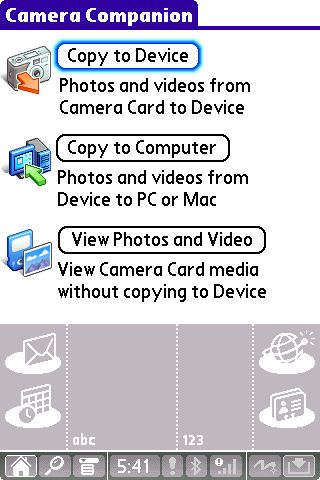
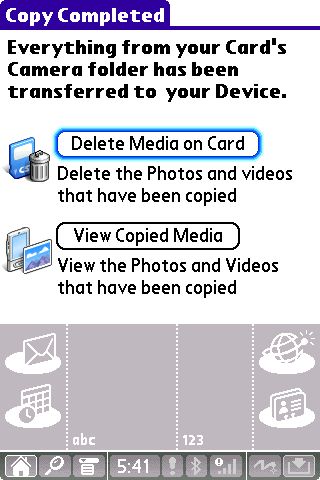
1. You can copy the images from the SD card to the LifeDrive. Once this
operation is complete, you will be asked if you would like to delete the media
off the SD card, or view the copied media.
2. You can copy the images from the SD card to your computer. This operation
will ask if you want to turn on Drive Mode which will enable the LifeDrive to
become a mounted drive on your PC when plugged in to a USB port. Copying files
is a fast operation given the fact that the LifeDrive uses USB 2.0
3. You can view the images directly from the SD card using the Media
application. Loading even large (1-2mb) images from the SD card is very snappy.
This application can come in really handy when you’re on vacation and don’t
care to lug a notebook computer with you to offload your digital pictures at the
end of the day. Of course, this will only be useful if you have a camera that
uses SD cards… That said, a CF adapter is supposed to be available soon. I
would find this helpful when using my little point and shoot Pentax camera, but
not as much with my new 8 mega pixel Nikon Coolpix 8800. This is only because I
tend to shoot a LOT of pix when on vacation and set the camera to the highest
resolution. With such a setting, each picture is over 23mb which would allow me
to only save around 170 pictures to the LifeDrive.
The other application that makes the LifeDrive a powerful pocket computer is
the new LifeDrive Manager File/Folder syncing application which resides on your
desktop computer (sorry Mac people, this is for Windows users only…). This
software allows you to drag and drop files and folders that will be synced both
ways. I had quite a bit of trouble getting the software installed. Each time I
tried installing it, it would get about 3/4th of the way through the
install when I would receive a popup with a 1316 network error. Clicking OK
would roll back the install. When I tried to then sync my Treo, it would never
connect. I thought FINE! I’ll just go uninstall the Palm Desktop and start from
scratch with the new software. No go though… every time I tried to uninstall,
it would get so far and then give me that same 1316 error. ARGH! Thank goodness
for Windows System Restore. I was able to restore back to before I had tried the
new installation. Come to find out that this is a bug that has to do with the
Windows MSI installer. Lisa Gade of
MobileTechReview.com knew exactly what I was talking about when I started
complaining to her, and she pointed me to a utility from Microsoft that would
allow me to uninstall the Palm Desktop so that I could then install the new
version. What a headache!
After I finally was able to get the new software installed, I began playing
with the LifeDrive Manager. This is a separate program to the Palm Desktop. It
even adds a icon to the tray.

The LifeDrive Manager icon is to the left of the TV icon.
Double clicking the icon brings up the LifeDrive Manager application (when
the LifeDrive PDA is plugged in to the USB cable). This application looks like a
regular file explorer.
It is actually a file explorer for the LifeDrive 4gb drive. It also allows
you to copy any files or folders from your computer’s hard drive to the
LifeDrive and keep them synchronized both ways every time you hotsync. So, if
you make a change on a file on your PC, the next time you sync, that change will
show up on your LifeDrive and visa versa. Even files that the LifeDrive can’t
actually open or view will be copied and synced.
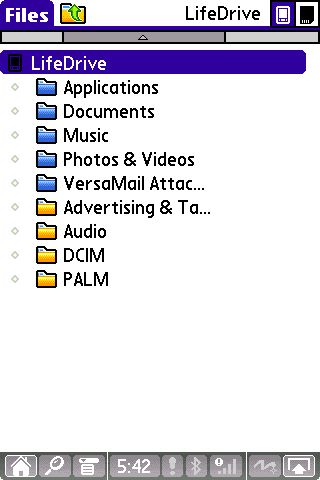
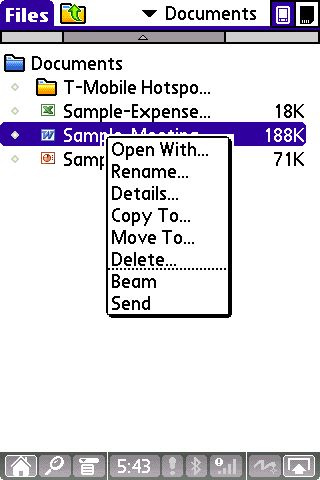
I did have a few problems opening Excel and Word documents that I had synced
to the LifeDrive. I kept getting errors that said I had a previous version of
Documents to Go installed on my device. My Treo has 7.000 built in, while the
LifeDrive has 7.005. Then sometimes when I would scroll around in an Excel
spreadsheet, I would get sys errors. This may be due to the fact that I first
synced the LifeDrive with all my Treo 650 data…
To sum things up, I have mixed feelings about the LifeDrive. It’s most
definitely a step in the right direction for palmOne. Who can scoff at 4gb of
built in storage on a PDA? Finally adding WiFi is also a real plus. But then
there’s the dim screen, sluggish performance when accessing files and the
biggest faux pas of all (in my opinion), the lack of a user replaceable battery.
Should you buy this PDA? It really depends on how many files, music, photos, and
videos that you need to carry around with you. I have a 1gb card on my Treo and
it is still half empty, so that should tell you that I don’t carry around THAT
much stuff on my PDA. But that’s just me. If you need the storage, can deal with
the deficiencies, then this just might be your dream device.
Price: $499
Pros:
Built in 4gb microdrive!
Built in WiFi
Screen rotation button
LifeDrive Manager,
File / folder syncing software
Cons:
Battery not swappable
A bit sluggish
Display not as bright as I would like
Slow soft resets
INIU Mini Portable Charger, Small 45W PD Power Bank, 10000mAh USB C in&Out Fast Charging Pocket Size Battery Pack, Travel Essentials Powerbank for iPhone 17 16 15 14 Pro Air, Xiaomi, Samsung S24 etc
15% OffDEWALT Heavy Duty 3-in-1 Mini Stylus Pocket Pen, Tablet Pens for iPad, EDC Touch Screen Pens, Ballpoint w/Touchscreen Tip, Keypad Tip, Compatible iPhone Stylus Pen, Extra Ink Cartridge, Gifts for Dad
15% OffProduct Information
| Price: | 499.0 |
| Manufacturer: | Palm |
| Pros: |
|
| Cons: |
|




Gadgeteer Comment Policy - Please read before commenting
Post your comments here on the palmOne LifeDrive Mobile Manager (Part 1) Review.
http://www.the-gadgeteer.com/palmone-lifedrive-review.html
Just click the POST REPLY button on this page.
If the applications are on the card is it still noticeable more sluggish than previous devices (eg T3 with app on card). Does the hard drive still spins if the application ids loading from card?
Julie, thanks for the review. Maybe I’ll change my mind after reading your software portion, but just the hardware specs/performance are enough to just disappoint. No user-replaceable battery is a joke, especially when such a feature is de facto on most PPCs. I think the placement of the headphone jack on the bottom of the unit is inconvenient to say the least. And the sluggishnesh and DIM DIM screen don’t really boil my potatoes.
At least Palm got the form factor right, and features seem right on. But for $499, why oh why no swappable battery? And I agree on the cradle, too – stingy of them to not throw the thing in.
Once you get past all the hoopla over 4GB and the high-flying name, you have:
1 bog-standard Palm, with wifi and a 4GB hard drive.
The drive of course sucks power, so the battery is big.
This of course makes the device both big and heavy, at least comparatively speaking.
No Cobalt.
Slow application starts and other latency due to the hard drive, negating one of the real edges that Garnet has over Windows Mobile.
Oh, and a hard reset of the device reportedly wipes the hard drive, although of course I haven’t tried it since I don’t have a Lifedrive.
An Axim with dual batteries and a 2GB SD card will set you back maybe another $100, and you get more capable gear all round – and still have a CF slot free for a GPS card or whatever.
Once again Palm comes out with an entirely underwhelming device. Pass.
Yawn. There is a very limited market for this kind of device that is also willing to pay $499. Another Palm screwup IMHO. There is still a large product gap between the Tungsten E2 and this device and the T5 ain’t it. I’ve have seen some say you can buy a Pocket PC and a 4 GB solid state CF card for less than this device. I don’t know if thats true but I imagine the numbers are pretty close. How many people want or need a 4 gig drive in their PDA especially since it is not removable, load slower and sucks up battery? Not many. Also no cradle for $500??? Puh-lease. Anyway thanks for the fast review Julie. I’m waiting for a VGA version of the HP 24XX series Pocket PC myself.
Thanks for this review, Julie. I’ve been looking forward to the LifeDrive for awhile, and although finances prevent me from purchasing one at this time, I will get one eventually and retire my T3.
The only thing I dislike about this, so far, is the lack of a cradle. I’m with you: When I’m home, I want my PDA resting in a cradle. I’d use the old cradle, but since they’ve switched *yet again* to a new “Universal Interface”, I can’t use my existing models. This is the biggest disappointment I’ve seen yet.
However…
I’ve been using Palms for the past 8 years, since I got my Palm Professional 1000. I’m sold on the OS, for all its flaws and foibles. I’ve tried a Pocket PC, and while they’re good, they can’t match the range (IMHO…not trying to start a flame war here) of software available for the Palm…especially the FREE software.
This is a solid PDA. Granted, it’s got Garnet. Will we ever see Cobalt? Probably not. But I’m satisified with this OS.
I’m not using my PDA for movies…I’ve got a laptop if I wanna watch a DVD.
I’m not using my PDA for music…I’ve an iPod and a MiniDisc player for that.
I use my PDA to store my contacts, to-do’s, grocery list, database….it’s information at my fingertips, which (once again, IMHO) is what a PDA is for. It’s got WiFi, which’ll be great…but the other bells and whistles? That’s just icing on the cake, and I’m trying to cut back on the sweets.
If the hard reset is initiated by the security protection while someone is trying to hack into your device, yes. Otherwise, a hard reset caused by a bad software bug or other problem leaves the data that is NOT on the 64MB partition alone (according to palmOne). Julie can test this though 😉
Agree about the speed issue. That’s always been a fave feature: instant response. However, if you do something that requires resources from the hard drive, and the drive is idle at the moment…
The ideal design would have used 64MB of RAM or ROM as the location of apps, with a running backup written to HD in the background when CPU utilization is low. Better yet, just use 4GB of flash to reduce size and improve perfomance/reliability.
Still, this device will suite some users perfectly. At least we got wi-fi, and BT, and a big battery, and the voice recorder back, and finally a multifunction indicator light (which IS supposed to turn green when fully charged). Guess we have to accept the fact that it is the only mainline PDA with an HD built in, and deal with the limitations of that.
Well your review made the appeal of this device somewhat comprehensible to me by comparing it to a Tablet. Judging it by that standard rather than as a PDA is helpful.
Because Palm (Source or Center or whatever the “red” logoed side of the company is called) has not made this clear! (Did they get the idea to split into red and blue companies from the silver age Superman imaginary story, btw?)
They are in a “Sculley Apple” era where they can come up with great features but fumble away their lead even while innovating in some respects.
$500? Right…
I just did a little test where I launched several apps from my 1gb SD card on the Treo 650 and timed how long it would take for them to launch. I then repeated the test on the LifeDrive using the same 1gb card. The speeds on the LifeDrive were pretty much the same as the Treo.
At one point, after hearing about the LifeDrive, I was looking forward to replacing my Zodiac 2 with it. I love my Zodiac 2, but its gaming capabilites have never been used or exploited to their fullest potential. I mostly, if any, play Bejeweled! 2 and other multi-platform friendly games. One thing it does have over any other mass-produced Palm OS device is dual expansion capabilities, and I usually have both slots filled at any given time.
I’d love to have the LifeDrive, but honestly it is still not quite complete in my opinion. With almost all PPC/Windows Mobile devices, and cell phones, having removable batteries. I just ordered my replacement backup PDA, and it isn’t a Palm OS device. I decided to try the PPC camp again and I’m getting a HP iPaq 2215. Once equipped, it will have the same capabilities as the LifeDrive, and be $50 or more less then a LifeDrive.
I love that it has both WiFi and Bluetooth, and a SDIO capable slot, but it still needs more done with it. I say wait until the LifeDrive 3 next year, and hope it fixes the original’s shortcomings with lack of true RAM, and removeable/replaceable battery. I just wish Palm had gotten it right this time, because at one point it was the PPC/Windows Mobile playing catch-up, now it is the other way around.
Hi!
i had a few questions for Julie/Judie:
1) Can the lifedrive be used for making PPT presentations to an external display? Whats the output port?Is it possible wirelessly using any software or device (accessory)? Does it come with a remote? Whats the best presentation software available for this in the market today?
2) Is the HDD response response TRULY slow enough to make it a showstopper?
3) Is the email client, always on, all the time, like Blackberry? Does email get PUSHED or is it PULLED?
4)Im planning to purchase the virtual keyboard? http://www.vkb.co.il to go with this. How does one assess compatibility of the device?
5) Whenever Skype mobile gets released, is this compatible with it?
thanks a lot. I am an old and loyal fan of your website from India. Made all my decisions after reading your reviews only.
Cheers
Athreya
I’ve been upgrading my Palm since my plastic Palm III, and have decided the technology forces telling me I need to constantly upgrade are just lying to me. My purchase Tungsten C was my last stop on the tech train.
Going further, I’m worried that this latest generation of devices (PSP, LifeDrive) is part of the American problem of litterally amusing ourselves to death. We need reality, not devices that keep us away from it.
I won’t disagree the siren call of a 4gig drive in my pocket isn’t aluring. I’ll just have to wait out this generation.
Can you give us a measurement of screen size? Similar to T5, Zodiac2?
JohnKes:
The screen is ~ 3.25 x 2.19.
Wow, Julie, your system tray is seriously overloaded!
BTW, why is this forum launching pop under ads on me?
dmccarty:
Yeah, I do have quite a few things in there don’t I? 😉 You might receive 1 pop under per day. I’ve not changed anything, this has been the case for over a year now.
Good review. I was hoping there’d be comparison pics to the T3/T5/E2 so I do not have to physically see the unit to imagine how big it is. I guess I’ll have a reason to go to CompUSA this weekend…
Also, does anyone know if the drive is flash or a microdrive or some other?
Raul
rromea:
Sorry for not having a stack up pic. I don’t have any other devices except for a Treo, Dell x50v and some OLD PDAs. Here are some pix.
The drive is a Hitachi Microdrive. It has moving parts like a full size hard drive.
Julie
I posted some questions earlier in this thread about making presentations using the LD. this is a very important feature for me. May I request you to kindly give it a thought and let me know abt it?
thanks
I can’t help you with this question. I have never really played with PPT presentations on a Palm or Pocket PC for that matter. The built in Documents to Go application will allow you to view PPT presentations.
It’s not dog slow, it’s just slower than what I would like it to be.
The app is only ‘on’ when you launch it. You have to pull the email.
I do not have an answer for you as I have not used that specific keyboard for any length of time.
Sorry, not sure of the answer to that question either… I’ve not used Skype. Maybe someone else can help answer the questions that I was unable to do.
Julie
thanks julie.
for me the ability to project PPTs on a large screen- preferably wirelessly- is critical.
i am hoping to get the Irma infrablue soon and will report back.
if anyone else has thoughts on PPTs i would be grateful.
Take a look at http://www.margi.com
I have not tried it myself, but they have an sd card which should allow you to make PPT presentations with a Palm device. If you are interested you could ask them if their card works with the LifeDrive.
Julie:
Thanks for your quick follow-up. Your pic on the left seems to show a longer LifeDrive than the Dell x50V. The pic on the far right seems to say they’re the same length. Is it because your camera was set at wide angle on the left? Maybe next time set it to 50 mm or something, zoom in a bit from 28 mm (I’m not really a photographer, though). Looked like you were using some kind of Nikon (5800). The LifeDrive looks smaller than I initially thought.
Raul
rromea:
The LifeDrive is about 1/8in longer and 1/4in thicker than the Dell.
As far as I know there is no Skype for Palm (at least yet, no idea about the future; last time the rumour about an up-coming Palm version came up, I think it was late 2004, they weren’t even working on it.) Possibly the task-switching that Garnet does as opposed to full multitasking might be problematic for them, who knows…
There is a Pocket PC Skype though, if Skype is important enough to influence the purchasing decision.
I just spent some quality time with one at a local CompUsa. Great design and feel, so-so screen, no cradle and WAY TOO SLOW!!! Palm managed to throw away one of the major advantages over the Pocket PC-speed. I would find it very frustrating to use this device. Can it be that Palm has scred up their last two high end models? Looks like it…How about a Palm with this design but thinner with an SD slot AND A CRADLE for $350?
Seems like a lot of people are nit picking about this device.
For those complaining about the speed, get a large SD card and run your programs from there. Yeah, when you have a physical hard drive you will always have a lag. To me except for songs or photos, I don’t see why so much space would be needed on a PDA. This device to me seems like an attempt by Palm1 to make a combo PDA and ipod.
To all the complainers about this not having a removable battery, Apple has been able to sell millions of ipods without one. I think a removable battery just invites loss of data. Once I got a Palm with a nonremoveable battery it seemed much more reliable than the first ones with removeable batteries. To me, it seems that dropping a unit with a removeable battery causes the battery to fall off half the time. My data is more important than being able to change batteries. Buy some kind of auxillary battery charger if you need more battery time. Just my 2 cents.
And to me the screenshots of the Blazer browser in operation look pretty freaking good.
Good review,
I’m a Zodiac 2 owner and computer technician by trade and am thinking about moving over to the Lifedrive for the extra harddrive space, built-in WIFI, etc. My questions are:
[INDENT]1. Would you replace a Zodiac 2 (outfitted w/1GB SD, Sandisk WIFI, etc) with a Palm Lifedrive?
2. You’ve reviewed both the Z2 and Lifedrive units…is the load times on the Lifedrive enough not to upgrade?
3. How do the two units compare performance wise?
NOTE: I’ve owned a Z2 for about 6 months and use it for both PIM, WIFI, etc. The Lifedrive has a few features that would be very handy like 4GB HD and built-in WIFI, which are both blessings since my external Sandisk WIFI can be annoying having the insert and remove anytime I use it and the HD storage could be used in my business for moving files, security updates, etc.
4. Finally, should I wait or purchase something else (Palm’s next Lifedrive, Dell Axim X50v, or Dell’s next Axim unit)?
[/INDENT]
I’m looking forward to you response and would appreciate complete honesty since making another change can be both time consuming and costly.
BTW, I’ve looked at the Dell Axim X50v before and cannot quite get ahold of the interface and software compared to the usual Palm interface and standard I’ve used previously. Is changing from Palm OS to PPC that difficult and how does Palm OS Garnet and Windows Mobile 2003 compare?
Thanks,
BrianS
I too had a Z2 with 1GB SD. Unfortunately it got stolen last month 🙁 . I am in the same boat as you – evaluating whether I should get another Z2 w/ 1GB SD or an LD. I’ve come to the conclusion that it is like a choice between a sports car and a minivan: fast performance, sexy package vs functionality in a single unified package. I look forward to Julie’s opinions too.
It’s hard for me to compare the Z2 and the Lifedrive since I haven’t had the Z2 in a long time. Judie still has hers, but she’s not tried the Lifedrive. Sooooo, here goes. If it were me, I would probably stick with the Z2. The screen is better on the Z2 from what I remember. It also has excellent controls for game play. I would just deal with the lower storage capacity because I don’t think I would personally need 4gb on my PDA. I only say that because I’m not using my PDA as an mp3 player or an image tank. In order to do either of those tasks I would want at least 80gb… and that isn’t going to happen anytime soon.
Performance on the Z2 vs. LifeDrive is another area where it’s hard for me to comment. All I can say is that I remember the Z2 bing very snappy.
Hope this helps…
Pay $499 for a device with a 4 GB HD and not use it? Deal with the associated lag (if you read the review the apps run from the HD) and poor battery life to run from an SD card? I don’t think so. As far as a removeable battery goes I don’t much care but alot of people do and it is a competitive factor that Pocket PC has going for it against Palm. Palm still acts like they are in a PDA market with no competition. Instead of going by what you saw on screenshots go and look at the actual screen. It might have been really nice two years ago but now it’s just average. I expect more from a $499 PDA.
Julie,
Thanks for the reply and I agree with you on many notions with Z2 being snappy and very useful. The harddrive and WIFI on the LD would be convenient, but as with most things…everything comes at a price.
Having everything built-in would also be convenient and helpful, but I’m going to have to wait and see what a LD can and cannot do compared with my present Z2 handheld.
If your partner still has her Z2 unit…I’d like know what she thinks in comparison…if that is possible.
Thanks again…
BrianS
Hi Brian, I am presently using the iPAQ 4700 as my daily driver, backed up with my Zod2. I am not buying the Lifedrive.
The Zodiac was and is (IMHO) one of the more innovative Palms to appear in ages. I could pop two 2GB SD cards in its slots and get many of the benefits of the LifeDrive while using media that could be carried over to my next PDA. I am hoping that Tapwave will continue to produce exciting devices.
For me, that is not the LifeDrive. :0/
Outstanding review. You answered quite a few questions that I hadn’t thought of yet. I have been watching the PDA market very carefully. I am a long time PDA user (I even had a Newton for a short time). My current unit is a CLIE 615T (you can see I like to hold onto things for a while). Of course, Sony discontinued the line here in the US last year, which was a shame as I thought they put out a pretty good product.
I appreciate the fact that PalmOne continues to move forward, but I’m still waiting. BTW, I am a Realtor, and I use the hell out of the CLIE. Primarily MLS, Contact Management, and mapping (mapopolis, GREAT product.) I have considered the Treo but it looks like the screen is just too small.
Anyway, again, great job, very informative.
If you do that, you may as well ignore this device entirely and get a T5. The whole point of the Lifedrive is the hard drive. The problem is the whole hard drive in a handheld-approach doesn’t fly for normal PDA users, at least not a mere 4GB drive.
The fact that the battery pops out of the handheld if dropped is a good thing. The forces that impact the device get diluted into the parts popping out to the left and right as opposed to a totally solid device where the force may concentrate in a way that something critical snaps.
It’s the same principle as having cars that deform a lot in accidents; the deformation of the car soaks up energy that would otherwise impact what’s inside the car… the people.
A properly engineered device won’t lose data just because the main battery pops out. There are backup batteries in any properly designed PDA… and a prudent user takes backups in addition to that. My PDA does automated backups to the SD card regularly and recovery from there is a snap.
The big issue with this device not having a removable battery is the fact that it’s a power hungry device to start with, and not having an easily swappable battery makes it impossible to carry a spare. You can work around it with external power packs, yes, but that’s not very elegant…
Also, an ipod and a PDA are different. Few people ever need their ipod to work… music is nice to have, but you won’t lose money if you can’t listen to it. Meanwhile, if you have data on your Lifedrive you absolutely must access or lose money (in a business situation) or miss a meeting because the Lifedrive was dead and didn’t remind you then battery time becomes a much more serious issue.
Well, if your lifedrive dies you can always open it up and get the microdrive..it’s a standard typeII CF card…
A great review – as always. I did have my heart set on a LifeDrive but I think I’ll hold off for now. In fact, I just managed to snag a Tungsten E for a rather cheap bargain price.
Anyway, I just wondered if you could post a bit more information about the software uninstall thing from Microsoft – I’ve got an old copy of Palm Desktop which is proving a proverbial pain in the rump to uninstall in order to install the new version with all the bells and whistles. A link would be great.
Many thanks and congrats on a snazzy new site – I was rather shocked at the new look (in a good way 😀 ).
Jeremy.
JeremyPryce:
You can download the free utility from Microsoft’s web site to fix the problem. Download and install the app, then run it from the Start Menu. Select the Palm desktop software from the list and it will remove the old installer data (it will not remove the actual software).
http://support.microsoft.com/default.aspx?scid=kb;en-us;290301
We bought two LifeDrives to test in our office environment, and both of them have been returned.
The first one died after two days. It went into a continual soft reset until it finally died. Now, I’d been reading other newsgroups and Palm forums saying that there could’ve been some application that might have caused the problem, but no software was installed on that model.
The second one faired a little long, so it supposed to be tested by the whole staff. That is, until the last person (an experienced Palm user, I might add) tried to do a hard reset (following the instructions posted at Palm’s website) and it didn’t recover. We followed their recommendations to try and recover the unit, but it didn’t work.
I’ve been one of the most vocal supporters for Palm at my job. It was on my recommendation that they get the two units in. It was also my recommendation that they return them.
As useful as the unit is, some factors could not be overlooked. Most important is the lag time in accessing the hard drive. I admit, it’s a great idea, but keeping the programs on it, and having to access the drive whenever you wanted to run them, isn’t the best solution.
Of course, the fact that two units we ordered both died didn’t help matters.
I’m going to steer clear of the LifeDrive. I’ll wait for the next Palm to come along. As long as it has WiFi and Bluetooth and Flash memory, it’d be a far better investment.
After my T3’s screen cracked while in a pants pocket this weekend (my fault), I bought a LifeDrive today. It’s still charging so I only have my few minutes with the Staples demo unit to go on, but I tapped the Info menu item while in the store and it said the unit has 64MB of RAM (55MB usable) and 4GB of LifeDrive space (3.55GB usable). Your review says it only has 32MB of RAM. What happened? Has the unit been updated since your review? Why else might your information be incorrect?
A related question is, can I install ALL apps and data using just the 64MB (my T3 wasnt even close to full) and keep the LifeDrive available solely for MP3 files (my primary intended use for it)? Or do I need to install apps on the LifeDrive for it to work properly? I hate to have to ask this kind of question, but there doesnt seem to be any Owner’s Manual in the box with my unit. Is this lack of proper documentation standard PalmOne policy? No cradle, no manual, and not one of my several expensive T3 accessories (two cradles, a USB cable, a car charger, a PalmOne keyboard, and, just purchased and received one day too late, a beautiful nSignia case) is usable with the new unit. This, after being assured on the phone two years ago by someone at PalmOne that the T3’s “universal” connector will be used “with all upcoming new models.” How cheesy can you get? I’ve still got a box somewhere full of old and useless accessories for my long-replaced 3C!
Another question: You had problems after sync’ing all your data from your Treo 650. Will I have similar problems with installing the LifeDrive’s Palm Desktop and/or sync’ing all my data from my T3?
1) the “64 MB” is actually a partition on the internal microdrive. The OS thinks it is RAM. The actual RAM is much smaller, maybe 6-10 MB 🙁 That is the main reason I bought a Zodiac2 to replace my previous one (recently stolen).
2) You should use the “64 MB” for programs, since it is easier for the OS to find things. Store your movies and music on the “drive” portion of the microdrive, since most multimedia apps are programmed to look primarily in external memory.
3) The manual may be a PDF file on the install disk.
4) Sell your accessories on eBay. There is still a market for them. This will help offset the high cost of your new LD. Perhaps you can find a cradle and case for it there too. New Palms have this new “universal connector”.
Look around here for more answers:
http://www.1src.com/forums/forumdisplay.php?f=151
A pity about Tapwave bowing out of the market – like Sony before them, they’ve discovered that ‘Palm’ and ‘innovative’ do not go together with ‘profitability’. :confused: I’ve seen the Palm LifeDrive in the stores, and my thought on the matter is that it’s WAY too big for everyday use – it’s almost the size of the Toshiba Libretto U100 I saw in the same store, or the QD0-01 which came out fairly recently, and those are full-fledged computers with WinXP, but with fewer features and even slower response times than those PCs.
I’ve always liked handhelds which actually performed snappily, which is why I’ve been fairly dissatisfied with most of the PocketPCs I’ve handled, with but a few exceptions… and with the way Palm’s going, I’m afraid their LifeDrive2 or whatever will be about the same. Which, in my case, is probably going to send me over to the PocketPC camp, since at least there I know they’ll probably be around for more than a few years.
Hi, I am new to the world of pda’s and would really appreciate some advice.
I originally intended to buy a Portable Media Player like an i-river or similar but thought to myself how nice it would be to have something that i could play a game on or better still access the internet with when i am not listening to music (primary reason) or watching movies.
Now i know you might be thinking that is not what the palmOne (judging by the pricetag) is for, but i am having trouble finding another piece of kit that i can access the web using wi-fi and listen and watch media with. The price doesnt really matter that much, i just want something portable that will let me do these 3 things. Obviously, the fact i can read email/docs etc is a bonus but not that fussed really.
Basically,
I am looking for a handheld device that has a decent battery – does anyone know if i can say, tuck the LD up in my rucksack and listen to music (also, i presume i could have mp3’s stored and create playlists etc??) with the screen switched off maybe, to save battery? is it kind of like an ipod but with the video and internet access bonus as well? What do you reckon to using one of these as a multi media device? good/bad idea and why. Is it ok to use for this intention? can you suggest any other devices?
Thanks for your time, any responses really appreciated.
Andy
I currently use a Tungsten T3 and when the screen recently cracked I bought a LifeDrive. I was so unhappy with it (it’s just too damn SLOW) that I returned it and had my T3’s screen repaired instead.
But now the new Palm T/X is out for $299, and if you get one of those instead and then buy a 2GB card for the SD slot, you should be able to get all the useful capabilities of the LifeDrive along with the speed of a conventional Palm-OS PDA, plus it has a newer OS, longer battery life, smaller size (thinner), lower weight, and you should be able to save a few bucks while you’re at it. If the T/X was available when my T3 broke, I’d have one today instead of my repaired T3 (which I’m pretty happy with, but the T/X is cool!)
Hope this helps!